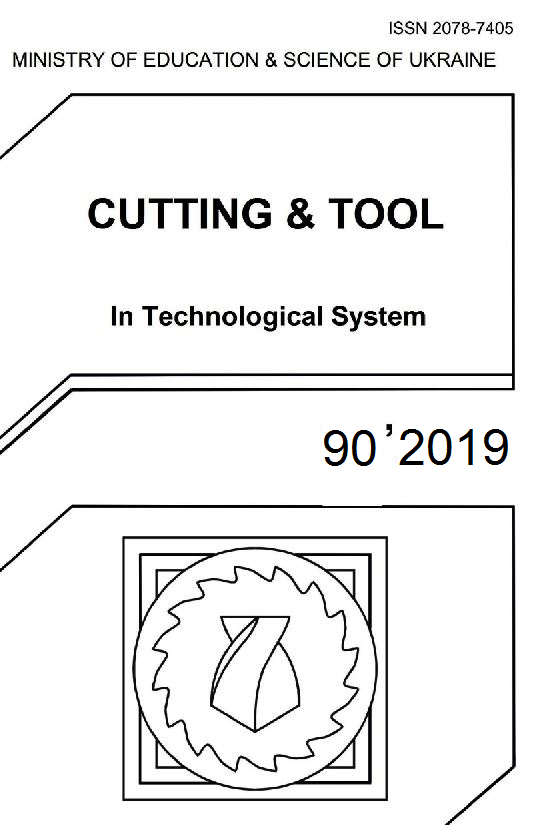EVALUATION OF VIRTUAL EFFICIENCY APPARATUS AND WELFARE PROCESSING IN RESERVOIRS WITH MULTENERGY IMPACT AND DIFFERENT FORM OF TRANSFER PERIPHERALS
DOI:
https://doi.org/10.20998/2078-7405.2019.90.07Keywords:
vibration treatment efficiency, multi-energy technologies, loading movement, physical model, dynamic model, reservoir cross-section.Abstract
The nature and effectiveness of the process of multi-energy vibration finishing and grinding treatment is given. The assumption is made that the effectiveness of vibration processing depends on the intensity of the movement of the reservoir loading, relative to its working surfaces. It has been established that the factors of this movement are the cross-sectional shape of the reservoir and the field of its oscillations. A description and selection of the parameters of the physical and dynamic models of the process for determining the cross-section of the reservoir is given. The study of the dynamic model allows us to conclude that the shape of the transverse cut and the oscillation fields of the reservoir affect the speed of the circulating movement of its load and the magnitude of the forces acting in the load, which directly affects the efficiency of the vibrating process. It has been established that the greatest importance is the speed in the tank “rectangular” with rounded transitions from the bottom to the walls of the overcut shape, which do not change the cut geometry, but only exclude the stagnation of the mobile load. In a reservoir of this cross-cut shape, the forces acting in the load take the least value. Comparison of the intensity of changes in the roughness of the surface of parts treated in tanks of the studied cross-cut shapes with the parameters of the load movement calculated according to the dynamic model shows that the intensity of the surface roughness changes the higher the higher the circulation circulation rate and the smaller the effective forces acting in the load. Such modes are implemented in tanks that have a "rectangular" and "ellipsoid" cut. For finishing operations in vibratory finishing of parts, it is necessary to use tanks that have a "rectangular" with rounded transitions from the bottom to the walls and an "ellipsoid" transverse overcut.References
Mitsyik A.V. Puti intensifikatsii vibratsionnoy otdelochno-zachistnoy obrabotki kombinirovaniem shem energeticheskih vozdeystviy na rabochuyu sredu i detali / A.V. Mitsyik, V.A. Fedorovich // AvIatsIyno-kosmIchna tehnIka I tehnologIya. – 2011. – # 6 (83). – S. 26 – 34.
Malkin D.D., Konoplyannikov Yu.A. Issledovanie protsessa ob'emnoy vibratsionnoy obrabotki. – Tez. dokl. nauchn.-tehn. Seminara «Vibratsionnoe shlifovanie, otdelka, uprochnenie». Rostov-na-Donu, 1969, s. 68 – 79.
Samodumskiy Yu.M., Yurkevich V.B., Levin I.N., Trunin V.B. O vyibore ratsionalnoy formyi rabochey kameryi pri vibratsionnoy obrabotke. – V kn.: Stanki i rezanie metallov. Rostov-na-Donu, 1974, s. 126 - 134.
Babichev A.P. Osnovyi vibratsionnoy tehnologii / A.P. Babichev, I.A. Babichev. – Rostov n/D: Izdatelskiy tsentr DGTU, 2008. – 694 s.
Medyanik V.A. Issledovanie effektivnosti protsessa vibroobrabotki v zavisimosti ot nekotoryih tehnologicheskih parametrov vibroustanovok: dis. … kand. tehn. nauk: 05.02.08 / Viktor Aleksandrovich Medyanik. – M., 1988. – 189 s.
Levengarts V.L. Issledovanie dinamiki i sovershenstvovaniya ustroystv dlya vibratsionnoy obrabotki detaley: dis. … kandidata tehn. nauk: 05.02.08 / Viktor Lvovich Levengarts. – Kaunas, 1981. – 186 s.
Blehman I.I., Dzhanelidze G.Yu. Vibratsionnoe peremeschenie. M., 1964, 412 s.
Blehman I.I. Metod pryamogo razdeleniya dvizheniya v zadachah o deystvii vibratsii na nelineynyie mehanicheskie sistemyi. – Izv. AN SSSR Mehanika tverdogo tela. 1976, # 6, s. 13 – 27.
Dyachenko V.I. Issledovanie protsessa vibroabrazivnoy obrabotki. – V kn.: Progressivnyie metodyi otdelochnoy obrabotki detaley mashin. Rostov-na-Donu, 1968, s. 32 – 48.
Downloads
Published
Issue
Section
License
Copyright Notice
Authors who publish with this Collection agree to the following terms:
1. Authors retain copyright and grant the Collection right of first publication with the work simultaneously licensed under a Creative Commons Attribution License that allows others to share the work with an acknowledgement of the work's authorship and initial publication in this Collection.
2. Authors are able to enter into separate, additional contractual arrangements for the non-exclusive distribution of the Collection's published version of the work (e.g., post it to an institutional repository or publish it in a book), with an acknowledgement of its initial publication in this Collection.
3. Authors are permitted and encouraged to post their work online (e.g., in institutional repositories or on their website) prior to and during the submission process, as it can lead to productive exchanges, as well as earlier and greater citation of published work.

